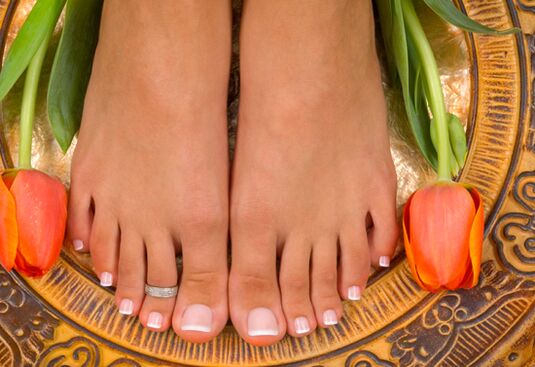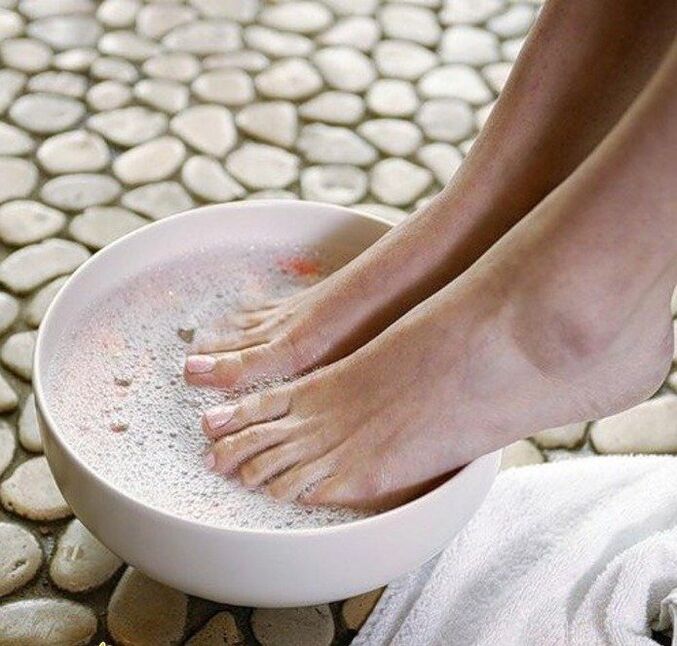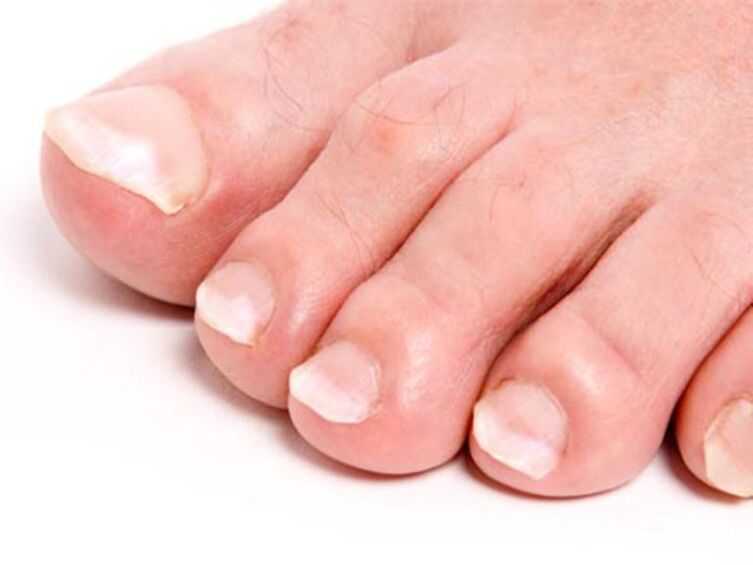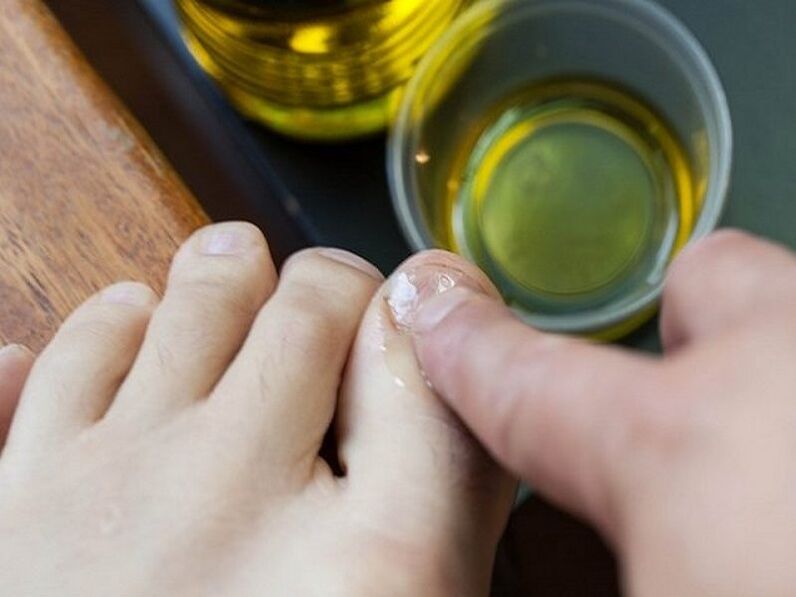
Nail fungus is an extremely unpleasant phenomenon. The disease can be infected anywhere, especially in summer. But the fight against him often takes a long time. A quarter of the world's population suffers, as the statistician says, from this scourge. We'll show you how to treat toenail fungus at home.
Vinegar against nail fungus
Few know that vinegar can be used to solve the rather complex medical problem of getting rid of nail fungus. Thanks to the availability of table cider vinegar (9% acid solution) and even vinegar essence (70% acid solution) available at the hardware store or in the market, there are many ways to treat toenail fungus with this product.
Self-medication with vinegar, of course, should be carried out only if the disease has not passed into a neglected form, and it is advisable to combine it with specially designed drugs.
But if nail fungus needs urgent treatment, there is no money and time to see a doctor, and there is no drug therapy, then you can use vinegar yourself. The main thing is that you adhere to the relevant safety rules.
Features of the use of vinegar
The main effect of using vinegar is to create an acidic environment in the area of infection by the fungus, preventing the growth of hyphae and the spread of spores.
Gradually, the fungus, lacking access to new sources of nutrients, dies, and the lack of much more robust spores prevents the possibility of the disease relapse.
At first glance, everything is very simple - how to destroy bacteria with an antiseptic. In fact, however, the fungus turns out to be very persistent because its body is not on the surface of the nail or skin, but penetrates into the thickness of the tissues.
In this respect, a positive result of the oncomycosis therapy can only be expected with strict regularity of the procedures, which leave the parasite no time for rehabilitation and penetration under the skin.
Before treating nail fungus, make sure that the concentration of acetic acid used is the same as that indicated in the recipe.
If vinegar essence is mentioned in the recipe, it is a 70% solution that must be dissolved or applied selectively. Table vinegar or table vinegar contains 6 or 9% acid. Failure to observe these data can result in the treatment ending with chemical burns.
Other than this point, there are no specific contraindications to vinegar treatment. Individual intolerance is very rare, but vinegar is such a common substance that patients are usually aware of this property of the body.
A burning sensation may well occur during the first few procedures, but this is normal and will go away over time. Otherwise, subject to safety regulations, vinegar does not pose a health risk.
Vinegar baths

Warm foot baths are considered an effective remedy for fungus, with regular use you can get rid of onychomycosis early without additional medication.
Vinegar baths are also a great way to prevent yeast infections. The procedure requires about 50 degrees warm water and a glass of vinegar with a concentration of 9%.
The water level in the pool should not be high, just up to your ankles. The feet are dipped in the solution and left there for 15 minutes.
Before taking the vinegar bath, it is recommended to do a full pedicure, including removing the affected areas of the nail plate and dead layers of skin, calluses and corns on the feet, but without applying a decorative coating on the nails.
When cutting and filing your nails yourself, you need to do it very carefully, as micro-damage to the skin can contribute to the spread of fungal infections.
Immediately after the vinegar bath, wipe your feet dry with a towel and put on cotton socks. Repeat three times a week.
Vinegar lotions
Lotions on areas affected by the fungus are best applied after baths in vinegar.
Pharmacy products as well as pure 9% vinegar are suitable for this, with which a cotton pad is moistened and applied to the nail for 15 minutes.
A more complex recipe: a mixture of vodka or medicinal alcohol at 40 degrees, glycerin and acetic acid 70% in equal proportions, mix until smooth.
A cotton swab moistened with a solution is held on the affected areas for 15 minutes, after which they put on socks made of cotton material. The course of treatment is a week, if necessary, you can repeat it after a few days.
Ointment against fungus on the feet
All existing local preparations are based on the following active ingredients:
- Bifonazole;
- Sertocanazole;
- Ketoconazole;
- Terbinafine;
- Naftine;
- Oxyconazole;
- Cyclopiroxolamine.
The choice of ointment for toenail fungus is made only after scraping the skin or the upper part of the nail. Based on the results of the analysis, it becomes clear which of the types of pathogenic microorganisms is the causative agent of mycosis:
- Epidermophytes;
- Trichotones;
- Dermatophytes;
- Microspores;
- Molds;
- yeast-like mushrooms.
Based on the results of the diagnosis, you should buy the best ointment that will cope with the detected causative agent of the fungus.
Antifungal ointments
All antifungal drugs designed to get rid of nail fungus are divided into 2 groups:
- Allylamine. These drugs penetrate deeply into the nail plate and completely destroy the fungal colony. After a cure, the concentration of the accumulated active ingredient helps to prevent a relapse for a long time, a healthy nail grows instead of the nail affected by the fungus.
- Azole. They disrupt the synthesis of the fungus by destroying its cell membrane. The action of the accumulation of drugs in the nail plate leads to the complete death of the infection.
If the affected area of the nail is still relatively small, you can get rid of the fungus with a special nail polish.
These funds are used as a normal pedicure varnish and applied directly to the affected nail in a thin layer twice a week.
For prophylaxis, healthy nails should also be painted on neighboring fingers, as fungal spores spread very quickly and easily in space.
Preparatory process

These guidelines will help you use the ointment more effectively against the fungus.
- If the fungus has attacked several parts of the body, these should be treated at the same time to prevent the disease from recurring.
- Apply the ointment not only on the affected nail or skin, but also on the adjacent areas.
- While applying the ointment, be careful of strict hygiene of both the affected area of the skin and the entire body.
- Before using the drug, clean the affected area thoroughly with antibacterial soap under running water. Then take an emollient bath. To do this, dilute 1-2 tablets of furacilin or potassium permanganate in 5 liters of warm boiled water. Soak your hands or feet in the solution for 10-15 minutes.
If, after several weeks of taking the drug, the first signs of a relapse of the disease do not appear, it is necessary to change the ointment and see a dermatologist.
Ointment with naftifine
Antifungal cream with the active ingredient naftifine hydrochloride, which contributes to the disruption of the cell wall structure of the infection. Penetrates into the deep layers of the skin. It also exists in the form of a solution.
It is used in the treatment of fungus on the feet, nails, and various lichen on the body. The agent is applied once a day to the affected, cleaned area and adjacent areas.
The duration of the course is from several to eight weeks with fungus on the skin. In the case of a nail infection, it is applied several times a day for six months.
Contraindicated in case of hypersensitivity to naftifine. Sometimes redness and burning of the skin may occur, but you should not stop treatment.
Terbinafine ointment
One of the safest and most effective antifungal drugs. Maybe this is due to the active ingredient terbinafine.
The ointment is applied thinly to the base of the nails and the adjacent areas of skin and massaged in. The process is repeated 1-2 times a day.
The course of therapy lasts from 14 days to 1 month. Usually the first results can be seen after the first two weeks. If no improvement is observed, it is recommended to replace the agent with another drug. The drug is allowed both for adults and for children from 2 years of age.
Ketoconazole ointment
This remedy is most effective for yeast infections, especially on the skin. Ketoconazole - the main active ingredient of the ointment, penetrates the deep layers of the skin and acts directly in the cells of the fungus, preventing their reproduction and causing death.
Good because it quickly relieves the symptoms of fungus. It is used once a day for a month if the lesion is localized on the hands and up to two months if it is localized on the legs.
Clotrimazole ointment
An effective antifungal agent is a cream that is used to treat the nail plate and skin. The main component of the drug is clotrimazole, which destroys the membranes of fungi and leads to their death, is applied to diseased nails twice a day.
The duration of treatment depends on the degree of development of the disease. But even after its symptoms disappear, treatment should be continued for a month.
The ointment is contraindicated in the event of individual intolerance to its components and liver diseases.
Cheap ointments: salicylic acid, zinc and sulfuric acid
Salicylic ointment can be used to successfully treat toenail fungus. It is used in two ways. In the first case, it is applied to the affected areas with a thin layer.
In the second case, compresses are made with the ointment at night. After such procedures, the skin on the feet begins to peel off a lot. Soap and soda baths speed up the exfoliation process.
Sulfur ointment is a tried and tested drug against nail fungus. It is used once a day at night for a week, the concentration is prescribed by the doctor individually.
It is a strong allergen, so it must be tested on a healthy area of skin before use.
Tea tree oil against mushrooms

An effective remedy for onchomycosis, tea tree oil acts directly on the cause of the disease - dermatophyte fungi.
Tea tree essential oil contains alpha terpinene, alpha fellandren, limonene, sabinene, cineole, and other substances that give its antiseptic and anti-inflammatory properties.
Before using the essential oil, it is necessary to conduct an allergy test - apply a little product to the skin of the wrist, if there is no irritation, redness, rashes and other reactions within 12 hours, the product can be used for medical purposes.
Otherwise, it must be diluted to a safe concentration or this technique must be abandoned entirely.
Ways To Use Tea Tree Oil:
- Foot bath with tea tree oil. Warm water is poured into a basin up to the ankles, 15-20 drops of essential oil are added and the feet are kept in it for twenty minutes, maintaining a high water temperature (45-50 degrees). The course lasts two months and you have to take the baths every day. During the treatment process, it is necessary to remove the affected areas of the nail plate with a file, nail nippers or scissors.
- Applying oil to the nail plate. If you do not react to undiluted tea tree oil, it is applied in its pure form to the affected areas of the nail to increase the effectiveness. Before this, the legs are steamed in warm water with the addition of laundry soap (it can be rubbed for better dissolution). The oil is rubbed into the nail plate with a cotton swab twice a day, the product does not need to be washed off.
How to cure toenail fungus quickly
The internal and external use of hydrogen peroxide for the treatment of infectious and other diseases has been described by Professor Neumyvakin in a book based on personal experience.
He mentions hydrogen peroxide as a prophylactic agent with antibacterial properties.
External use of hydrogen peroxide for the treatment of fungal infections is carried out after steaming the feet in warm water with dissolved soda at the rate of one teaspoon per liter.
When the nail plates become soft, use a nail clipper to pinch off a small fragment of the affected nail area and soak it on the nail plate with a 3% peroxide solution.
Leave on fingernails for 10-15 minutes or feet for 40 minutes to an hour. Do the procedure twice a day until the symptoms of the yeast infection are gone.
To reduce the evaporation of peroxide and increase the intensity of the impact, the nail plate is wrapped in plastic wrap with lotion.
After the exposure time has expired, rinse your toes and hands thoroughly under running water.
For therapeutic and prophylactic purposes, it is recommended to instill the nail cavity with hydrogen peroxide three times a day.
Baths for hands and feet (depending on the location of the onychomycosis) with hydrogen peroxide achieve good results.
Dilute 3% hydrogen peroxide in water at a temperature of 40-50 degrees at the rate of two tablespoons per liter of water. The duration of the procedure is fifteen minutes, the regularity of the procedure is twice a day for a week.
Other folk remedies
Comprehensive treatment of toenail fungus with folk recipes based on hydrogen peroxide allows you to destroy the fungus and permanently get rid of the unpleasant smell and other accompanying symptoms.
Two effective folk remedies for fungal infections:
- Recipe with Peroxide 1. To prepare the mixture you will need cleared soda (0. 5 cups), hot water (4 cups), 3% hydrogen peroxide (0. 25 cups) and half a cup of magnesium sulfate or Epsom salt. Mix all ingredients thoroughly and add another quarter cup of vinegar. Soak a cotton swab with the resulting solution and fix it with a plaster on the nail plate affected by the fungus. The bandage must be renewed every ten hours, the duration of treatment is one month.
- Peroxide Recipe 2. The procedure for treating mushrooms according to this recipe consists of three steps. First of all, it is necessary to prepare a solution for the treatment of the surfaces of the nail and skin affected by the fungus - mix 3% vinegar and peroxide in 3% concentration in a ratio of 1: 1. This mixture is applied to the feet while it is sizzling. The second stage is to dip fingers with a fungal infection of the nail in a weak solution of bleach in water for half a minute, then rinse them thoroughly under running water and wipe dry with a towel. Finally, tea tree oil is mixed with Vaseline in equal proportions and applied to the nail plate. Wear warm socks or gloves (if this technique has been used to treat fingernail cancer). The course of treatment is a week.
- Novocaine lotion. A very simple but effective folk remedy in the treatment of mushrooms is novocaine lotion. Simply soak a piece of cotton wool in novocaine and apply it to the mushroom overnight. Just two such lotions will be enough to get rid of the fungus forever.
- Tincture of apricot resin: 1 tablespoon of the resin removed from the tree, pour a glass of vodka, leave for three days. Lubricate the skin of the feet and nails with this solution. Shake well before each use. It took us a month for the treatment, the affected nails were cut off when they were peeled off, and new, healthy nails grew. Upon examination, the doctor confirmed the fact of recovery. I can recommend using old, thickened sunflower oil here too.
- Garlic applications: I took a clove of garlic, squeezed it out with a garlic press, applied the mass to the nail, covered it with cellophane and wrapped it in a bandage or put a fingertip on it. I left the bandage on until morning, for the first few days I felt a throbbing pain, like an abscess, but I had to endure it. The procedures were repeated daily and new nails grew.
- Strong coffee. Few people know that regular but strong coffee is a very good folk remedy for treating fungus. Make your coffee stronger and just dip your hands or feet in the cup depending on where you got the fungus. This procedure is best done in the evening before going to bed. The fungus completely disappears after several such evening procedures. At the same time, the skin becomes smooth and the pain goes away quickly.


















